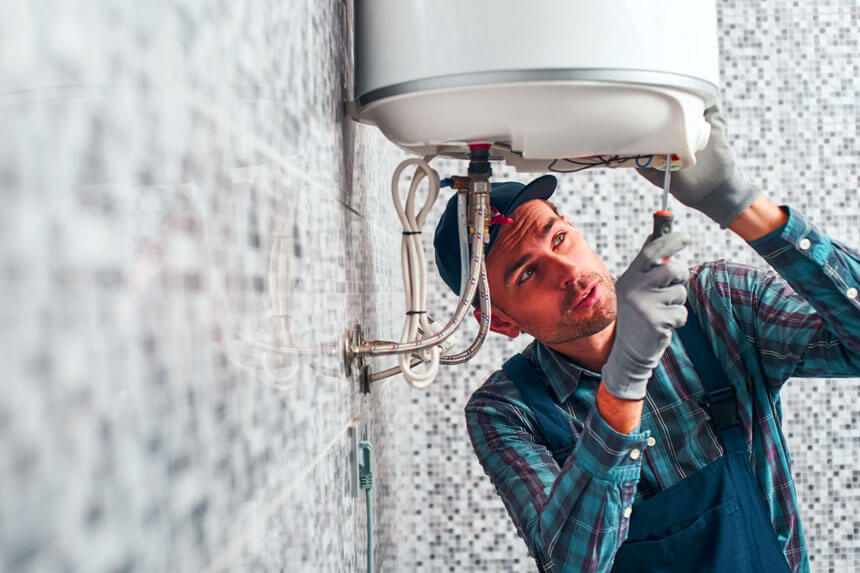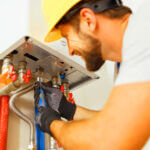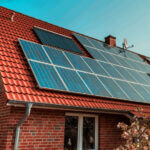Common water heater problems affect millions of households each year, from insufficient hot water to strange noises and unexpected leaks. Most water heating issues stem from sediment buildup, aging components, or simple maintenance neglect. You can fix many typical heating malfunctions yourself or know when to call a professional, saving both money and frustration while ensuring reliable hot water systems for your home.
- Common Water Heater Problems
- Why Your Water Might Not Be Hot Enough or Runs Out Too Fast
- Causes of No Hot Water at All and How to Check Safely
- Unusual Noises, Leaks, and Discolored or Smelly Water
- High Energy Bills or Slow Heating – How Efficiency Suffers
- When to Repair vs When to Replace – Age, Lifespan, and Warning Signs
- Basic Safety Checks – TPR Valves, Scald Prevention, and Maintenance Habits
Common Water Heater Problems
Water heaters account for 25% of home energy use and last 8-12 years on average, making them critical household utilities that demand attention when problems arise. The most frequent water heater problems include inadequate hot water supply, complete loss of heating, unusual sounds, and visible leaks. Energy Star estimates that eight million water heaters are purchased annually in the States, highlighting the widespread nature of these appliance malfunctions.
Sediment buildup causes many hot water tank problems. Sediment eventually settles on the bottom or sides of the tank. A buildup of sediment in the water tank can cause the heating element to work less efficiently, blocking heat transfer between the burner/heating element and the water. This creates barriers between heating elements and water, reducing efficiency and causing strange noises. Regular maintenance prevents most sediment-related problems and extends your unit’s lifespan significantly.
Understanding your heating system malfunctions helps with troubleshooting. Electric models use heating elements that can fail, while gas units rely on pilot lights and burners. Both types face similar challenges from mineral deposits and normal wear, but solutions differ based on your specific system. Modern smart water heaters with remote control, energy monitoring and learn user habits to optimize performance can help detect problems early.
Why Your Water Might Not Be Hot Enough or Runs Out Too Fast
Insufficient hot water usually indicates thermostat failures, heating element failure, or an undersized tank. The factory temperature for water heaters is 120 degrees Fahrenheit, but this may be too hot or not hot enough for some users. This represents one of the most common domestic water heating difficulties homeowners face.
Start by checking your thermostat setting to rule out simple temperature inconsistency. If water feels too cold, increase the temperature to 140 degrees and wait one hour before testing again. For electric units, sediment build-up can cover heating elements, causing them to overheat and fail. Gas models may have pilot light issues or gas supply problems affecting performance, contrasting with optimal heater performance.
Your household size matters significantly for heating equipment issues. A family of four needs roughly 50-80 gallons of storage capacity. If you consistently run out of hot water during normal usage, your tank may be too small for your needs. Consider equipment aging as well – older units lose efficiency as components wear down and mineral deposits accumulate inside the tank.
Causes of No Hot Water at All and How to Check Safely
Complete hot water loss often stems from power issues, failed heating elements, or gas supply problems. A very common reason for an electric water heater not working is a tripped circuit breaker. Always check your electrical panel first before investigating further, as this represents a basic water heater breakdown scenario.
For electric models, reset any tripped breakers and verify power reaches the unit. Look for indicator lights or digital displays showing normal operation. Heating element failures can occur without warning, requiring professional replacement. Check the pilot and control valve, ensuring the thermocouple is functioning correctly for gas units, but exercise extreme caution around gas connections.
Gas water heaters depend on proper ventilation and gas supply as part of their HVAC systems integration. Never attempt gas line repairs yourself – call professionals for any gas-related issues. A faulty thermocouple (the safety device that detect pilot flames) often causes gas units to shut down completely. This safety feature prevents gas leaks but requires professional service to repair or replace.
Unusual Noises, Leaks, and Discolored or Smelly Water
Strange sounds from your water heater usually indicate sediment buildup problems at the tank bottom. If you hear a rumbling, popping, or cracking sound from your water heater, it often indicates a buildup of sediment at the bottom of the tank. These deposits heat up and shift around, creating the disturbing noises you hear, representing a clear departure from efficient water heating.
Sediment and Maintenance Steps
Annual flushing the tank removes accumulated sediment and prevents noise issues. I recommend draining sediment from your water heater at least once a year to maintain efficiency and prolong the life of the unit. If you live in an area with hard water, you may need to do it more frequently. Connect a garden hose to the drain valve, turn off power and cold water supply, then drain several gallons until water runs clear. This simple maintenance step improves efficiency and reduces wear on internal components.
Rust, Odor, and Bacterial Issues
Bacterial growth leads to smelly water, often described as a “rotten egg” smell. Flush your system with water and hydrogen peroxide solution to eliminate bacteria. For persistent odors, briefly increase temperature to 140 degrees to kill bacteria, then return to safer temperatures.
Rusty or discolored water signals tank corrosion or tank deterioration. Either the sacrificial anode rod needs to be replaced or the tank itself is beginning to rust, often due to corrosion at the steel lining. Replace anode rods every few years to prevent tank damage and extend unit life as part of your plumbing infrastructure maintenance.
High Energy Bills or Slow Heating – How Efficiency Suffers
Rising energy costs often indicate declining water heater efficiency. Sediment buildup can cause the lower heating element to fail. So learning how to drain a water heater and flushing offers a payback in lower energy bills and will extend the life of your water heater. Regular maintenance prevents this expensive problem and maintains optimal heater performance.
Temperature and pressure relief valve problems also waste energy. These safety devices should activate only during dangerous pressure buildups, not during normal operation. Leaking relief valves signal internal pressure issues or valve failure requiring immediate attention to prevent water heater breakdowns.
Modern energy efficiency standards are pushing homeowners toward heat pump water heaters. The final standards for residential water heaters align with recommendations from various stakeholders, including efficiency and environmental advocates, with new requirements starting in 2029. HPWHs use electricity to transfer heat from the air or ground to heat water, making them far more energy-efficient than conventional electric or gas water heaters.
Smart thermostats and monitoring systems help optimize energy usage. Some newer models learn your usage patterns and adjust heating schedules accordingly, reducing unnecessary energy consumption during low-demand periods, representing the evolution from basic problems (derived from Latin “problema,” meaning difficulties) to sophisticated solutions.
When to Repair vs When to Replace – Age, Lifespan, and Warning Signs
With proper maintenance, a tank water heater tank should last six to 12 years. A tankless water heater can last for more than 20 years. Age becomes a critical factor when deciding between repair and replacement, especially for units approaching the 10-year mark, highlighting the polysemy of “heater” – both as an appliance and metaphorically as something that intensifies situations.
Frequent repairs indicate approaching end-of-life. If you find yourself making frequent hot water heater repairs, it may be more cost-effective in the long run to replace your water heater. Calculate total repair costs over the past year – if they exceed half the replacement cost, consider upgrading to avoid continued hot water heater troubles.
Tank lifespan varies based on water quality, usage patterns, and maintenance history. Hard water wreaks havoc on a water heater and can reduce its service life by 2 or more years. Units in garages or crawl spaces face temperature extremes that accelerate wear and reduce operational life, potentially causing thermal shock in extreme cases.
Look for these definitive replacement signals: persistent leaks from the tank itself, rust-colored water after flushing, excessive noise despite maintenance, and multiple component failures within short timeframes. These indicate systemic problems that repairs cannot solve economically, representing the opposite of reliable hot water systems.
Basic Safety Checks – TPR Valves, Scald Prevention, and Maintenance Habits
Temperature and pressure relief valves serve as critical safety devices preventing tank explosions. Leaks are usually the result of pressure buildup inside the tank. This happens when the water pressure or temperature is too high, or when the unit’s relief valve is not working properly. Test these valves annually by lifting the lever briefly to ensure proper operation as part of your home heating systems maintenance.
Never ignore TPR valve leaks or disable these safety features. They protect your home from potentially catastrophic tank failures. Professional inspection ensures these valves function correctly and meet current safety codes. Replace faulty relief valves immediately – the cost is minimal compared to potential damage from tank failure or rare electromagnetic interference issues in smart models.
Scald prevention requires proper temperature settings and mixing valves where appropriate. Keep residential water heaters at 120 degrees or below to prevent burns, especially in homes with children or elderly residents. Some applications need higher temperatures, but install mixing valves to reduce outlet temperatures safely.
Annual maintenance includes checking electrical connections, inspecting gas venting systems, testing safety devices, and flushing the tank thoroughly. If you live in an area with hard water, you may need to do it more frequently. For most systems, an annual flush is recommended. However, if you live in an area with hard water, consider scheduling flushes every six months to prevent excessive mineral buildup. Professional inspections catch problems early and ensure safe, efficient operation.
Create a maintenance schedule including monthly visual inspections, semi-annual tank flushing, annual anode rod checks, and professional service every few years. This proactive approach prevents most water heater issues and maximizes your water heater investment while ensuring family safety and avoiding the water heater breakdowns that plague neglected systems.
Bottom Line: Most water heater problems stem from preventable causes like sediment buildup and poor maintenance. Regular care extends unit life significantly, while recognizing early warning signs helps you plan replacements before emergency situations arise. When in doubt, consult professionals for safety-critical repairs or complex troubleshooting to maintain your reliable hot water systems.














